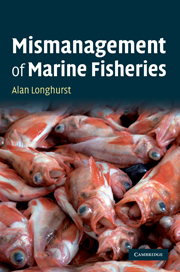Book contents
- Frontmatter
- Contents
- Preface
- 1 From certainty to doubt in fishery science
- 2 The ecological consequences of the exceptional fecundity of teleosts
- 3 Indeterminate growth, negative senescence and longevity
- 4 Marine ecosystems: their structure and simulation
- 5 The natural variability of fish populations and fisheries
- 6 Has sustainability in fishing ever been achieved?
- 7 What is the real state of global fish populations?
- 8 The mechanics of population collapse
- 9 Why don't some fish populations recover after depletion?
- 10 Is the response of the fishery science community appropriate?
- 11 Conclusion: sustainability can be achieved rarely and only under special conditions
- Index
2 - The ecological consequences of the exceptional fecundity of teleosts
Published online by Cambridge University Press: 05 July 2014
- Frontmatter
- Contents
- Preface
- 1 From certainty to doubt in fishery science
- 2 The ecological consequences of the exceptional fecundity of teleosts
- 3 Indeterminate growth, negative senescence and longevity
- 4 Marine ecosystems: their structure and simulation
- 5 The natural variability of fish populations and fisheries
- 6 Has sustainability in fishing ever been achieved?
- 7 What is the real state of global fish populations?
- 8 The mechanics of population collapse
- 9 Why don't some fish populations recover after depletion?
- 10 Is the response of the fishery science community appropriate?
- 11 Conclusion: sustainability can be achieved rarely and only under special conditions
- Index
Summary
‘The codfish lays ten thousand eggs, the homely hen but one But the codfish doesn't cackle to tell us what she's done . . .’
anonIt will be useful to begin this investigation of the sustainability of fisheries and the concept of surplus production by enquiring whether the organisms that comprise the bulk of global catches have any special biological characteristics relevant to the argument. Teleost fish dominate the vertebrates of interest to fisheries, and so discussion in the following chapters shall be concentrated on this group, although not to the exclusion of the selachians and marine mammals.
Teleosts have three biological characteristics that strongly differentiate them from all terrestrial mammals and birds:
their anomalously high fecundity, which is orders of magnitude greater than that of any other vertebrate and is habitually attributed to the rigours of the transient passage of the growing larvae through the planktonic ecosystem, with all that that involves;
their pattern of life-long growth, which has been almost totally neglected by fishery science, but which has important implications for it; and
the characteristic variability of their annual reproductive success, which appears to be higher than is typical of terrestrial vertebrates.
- Type
- Chapter
- Information
- Mismanagement of Marine Fisheries , pp. 16 - 33Publisher: Cambridge University PressPrint publication year: 2010



